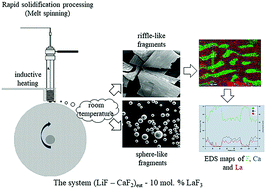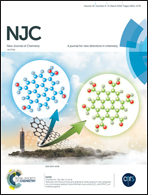Analysis of the extremely rapidly cooled molten system (LiF–CaF2)eut–LaF3
Abstract
A rapid solidification process (melt spinning) was applied to the fluoride molten salt system (LiF–CaF2)eut–xLaF3 (x = 0, 5, 10, 20, and 30 mol%). Two types of undercooled fragment were identified: riffle-like and sphere-like fragments that differ in morphology, but whose phase composition seems to be comparable. The phase composition of these rapidly cooled samples revealed the presence of a metastable fcc type phase based on (Ca0.65La0.35)F2.35, in contrast to when the system was spontaneously cooled, which showed only the presence of the initial components. The cell parameters of the metastable phase vary based on the composition and due to fast cooling. After thermal relaxation the metastable phase decomposes to CaF2 and LaF3 phases.



 Please wait while we load your content...
Please wait while we load your content...